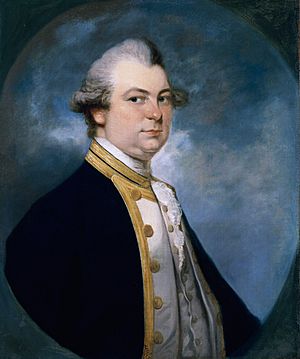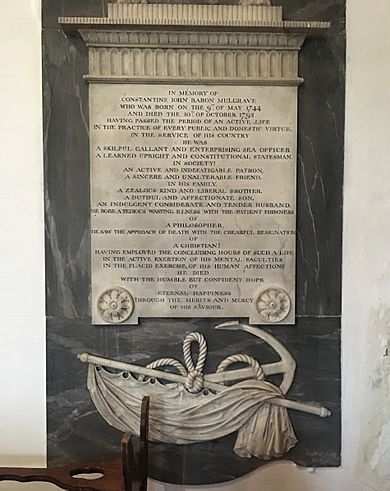Constantine Phipps, 2nd Baron Mulgrave facts for kids
Quick facts for kids
The Lord Mulgrave
|
|
|---|---|

Phipps around 1779
|
|
| Birth name | Constantine John Phipps |
| Born | 30 May 1744 Whitby, Yorkshire, England |
| Died | 10 October 1792 (aged 48) Liège, Liège Prince-Bishopric |
| Allegiance | Kingdom of Great Britain |
| Service/ |
Royal Navy |
| Service years | 1759–1792 |
| Rank | Captain |
| Commands held |
|
| Battles | |
| Relations | Constantine Phipps (father) |
Constantine John Phipps, 2nd Baron Mulgrave (born May 30, 1744 – died October 10, 1792) was an English explorer and a brave officer in the Royal Navy. He fought in two big wars: the Seven Years' War and the American War of Independence. He took part in many battles and important events. Constantine also inherited a special title, which helped him have a successful career in the British Parliament. He held several important government jobs later in his life.
Contents
Early Life and Family
Constantine John Phipps was born on May 30, 1744. He was the oldest son of Constantine Phipps, who was the 1st Baron Mulgrave. His mother was Lepel Hervey.
Constantine went to a famous school called Eton College. There, he became good friends with Joseph Banks. Joseph Banks was a well-known English naturalist and botanist. He loved studying plants and nature.
Adventures at Sea
In January 1759, when he was just 14, Constantine joined the Royal Navy. He started as a cadet on a large ship called HMS Monmouth. His uncle, Captain Augustus Hervey, was the commander.
Constantine stayed with his uncle and moved to another ship, HMS Dragon, in 1761. He was part of the British attack on Martinique. Because he did well, he was promoted to lieutenant in 1762. He then helped in the siege of Havana, a big battle in Cuba.
He was promoted again in 1763 to command a smaller ship, the HMS Diligence. Later, in 1765, he commanded the Terpsichore. In 1766, he sailed to Newfoundland as a lieutenant on HMS Niger. His friend, the naturalist Joseph Banks, joined him on this trip to study nature. From 1767 to 1768, Constantine commanded HMS Boreas in the English Channel.
Exploring the North Pole
Constantine Phipps became a Member of Parliament in 1768. This meant he helped make laws for the country.
On June 4, 1773, Phipps began an exciting journey. He set off from Deptford on a special trip towards the North Pole. He had two ships for this adventure: the Racehorse and the Carcass.
On board, he had Dr. Charles Irving as a naturalist and doctor. Olaudah Equiano, a famous writer and abolitionist, also joined the expedition. Israel Lyons was the astronomer, studying the stars. A young boy named Horatio Nelson was also a midshipman on the Carcass. Nelson later became one of Britain's most famous naval heroes.
They sailed past Svalbard to a group of islands called the Seven Islands. But thick ice stopped them from going further. They had to turn back and returned to England in September.
During this voyage, Phipps was the first modern European to describe the polar bear and the ivory gull. He wrote about his discoveries in a book called A Voyage towards the North Pole undertaken ... 1773, published in 1774.
On September 13, 1775, Constantine inherited his father's title and became the Baron Mulgrave. In 1777, he became a Member of Parliament for Huntingdon. He was also appointed as one of the Lords of the Admiralty, which meant he helped manage the Royal Navy.
He continued his active naval career. In 1778, he commanded the large ship HMS Courageux. He played an important role in the Battle of Ushant on July 27, 1778. Phipps led an attack on a big French ship, but the battle ended without a clear winner.
Phipps stayed in command of the Courageux until 1781. He mostly served in the English Channel. In January 1781, he captured a French ship called Minerve during a storm. After the American War of Independence ended, the Courageux was taken out of service. Phipps went ashore and never served at sea again.
Later Life and Legacy
Constantine Phipps remained a Member of Parliament until 1784. He then took on new government roles. In 1784, he became the Paymaster of the Forces, managing military payments. He also became a commissioner for Indian affairs and a Lord of Trade and Plantations, helping with trade and colonies. He had to leave these jobs in 1791 because of poor health.
In 1790, he was given another title, Baron Mulgrave of Mulgrave in Yorkshire. This allowed him to join the House of Lords, another part of the British Parliament. He was also a member of important scientific and historical societies.
Constantine Phipps once hosted a dinner party for his miners deep underground in the Blue John Caverns in Castleton. Today, that specific cavern is named after him.
He passed away in Liège on October 10, 1792. His brother, Henry Phipps, inherited his Irish barony title.
See also
- Phippsøya, the largest island in the Sjuøyane group, is named after him.


